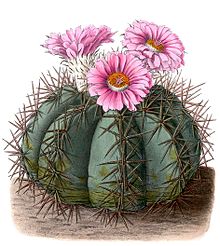Echinocactus
| Echinocactus | ||||||||||||
|---|---|---|---|---|---|---|---|---|---|---|---|---|

|
||||||||||||
| Systematics | ||||||||||||
|
||||||||||||
| Scientific name | ||||||||||||
| Echinocactus | ||||||||||||
| Link & Otto |
Echinocactus is a genus of plants from the cactus family(Cactaceae). The botanical name of the genus is derived from the Latin words echinus for 'hedgehog' and cactus for 'cactus'. He refers to the spherical shoots and their thorns. The best-known type of the genus is the so-called "mother-in-law chair " ( Echinocactus grusonii ).
description

The body of Echinocactus plants is spherical, with individual species also somewhat flattened or short-cylindrical. The plants can be single or multi-headed, but they are always ribbed and hard-fleshed. Echinocactus has yellowish woolen hairs on its head, which makes it easy to distinguish the genus from the "hairless" species of the Ferocactus genus that occur in the same region . The large areoles are elongated, in some species one areole merges directly into the next. There are strong thorns on the areoles .
The flowers are usually yellow, more rarely reddish, and appear in the apex of the plants. Narrow, pointed scales and woolly areoles sit on the pericarpel and the flower tube. The spherical or slightly elongated fruits are covered with scales and wool.
Distribution and systematics
The genus Echinocactus occurs from the arid regions in the south of the USA to central Mexico . Echinocactus shapes the landscape there with its large spherical cacti.
The genus Echinocactus was established in 1827 by Heinrich Friedrich Link and Christoph Friedrich Otto . The type species is Echinocactus platyacanthus . In the 19th century almost all ribbed ball cacti and some ribbed columnar cacti were listed under Echinocactus . In Karl Moritz Schumann's general description of the cacti , 138 North and South American species were grouped into 11 subgenera. Nathaniel Lord Britton and Joseph Nelson Rose counted their four-volume work The Cactaceae exclusively North American cacti in the genus Echinocactus . Synonyms for Echinocactus Link & Otto are Echinofossulocactus Lawr. (1841), Homalocephala Britton & Rose (1922), Emorycactus Doweld (1996), Meyerocactus Doweld (1996) and Kroenleinia Lodé (2014).
Six species are still included in the genus Echinocactus , two of which are subspecies:
- Echinocactus grusonii Hildm.
-
Echinocactus horizonthalonius Lem. :
- Echinocactus horizonthalonius Lem. var. horizonthalonius
- Echinocactus horizonthalonius Lem. var. nicholii L.D.Benson
- Echinocactus parryi Engelm.
- Echinocactus platyacanthus Link & Otto
-
Echinocactus polycephalus Engelm. & JMBigelow :
- Echinocactus polycephalus Engelm. & JMBigelow subsp. polycephalus
- Echinocactus polycephalus subsp. xeranthemoides J.M.Coult.
- Echinocactus texensis Hopffer
Individual evidence
- ^ A b c Edward F. Anderson: The great cactus lexicon. Eugen Ulmer Verlag, Stuttgart, 2005, ISBN 3-8001-4573-1 .
- ↑ Patricia Hernández-Ledesma, Walter G. Berendsohn, Thomas Borsch, Sabine Von Mering, Hossein Akhani, Salvador Arias, Idelfonso Castañeda-Noa, Urs Eggli, Roger Eriksson, Hilda Flores-Olvera, Susy Fuentes-Bazán, Gudrun Kadereit, Cornelia Klak , Nadja Korotkova, Reto Nyffeler, Gilberto Ocampo, Helga Ochoterena, Bengt Oxelman, Richard K. Rabeler, Adriana Sanchez, Boris O. Schlumpberger, Pertti Uotia: A taxonomic backbone for the global synthesis of species diversity in the angiosperm order Caryophyllales. In: Willdenowia. Volume 45, number 3, 2015, pp. 281-383 ( doi: 10.3372 / wi.45.45301 ).
further reading
- Mario Daniel Vargas-Luna, Patricia Hernández-Ledesma, Lucas Charles Majure, Raúl Puente-Martínez, Héctor Manuel Hernández Macías, Rolando Tenoch Bárcenas Luna: Splitting Echinocactus: morphological and molecular evidence support the recognition of Homalocephala as a distinct genus in the Cacteae. In: PhytoKeys . Volume 111, 2018, pp. 31-59, ( doi: 10.3897 / phytokeys.111.26856 ).
Web links
- Echinocactus on the Germplasm Resources Information Network (GRIN), USDA , ARS , National Genetic Resources Program. National Germplasm Resources Laboratory, Beltsville, Maryland. Retrieved July 8, 2019.